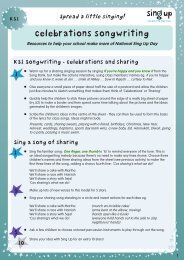Voice development over the lifespan - Sing Up
Voice development over the lifespan - Sing Up
Voice development over the lifespan - Sing Up
You also want an ePaper? Increase the reach of your titles
YUMPU automatically turns print PDFs into web optimized ePapers that Google loves.
How <strong>the</strong> voice ages throughout <strong>the</strong> <strong>lifespan</strong><br />
2. HOW THE VOICE CHAPTER WORKS 4<br />
<strong>Voice</strong>s age in a similar way to our bodies. Our voices spend <strong>the</strong> first twenty or so years making <strong>the</strong> transition<br />
from birth to adulthood. There is <strong>the</strong>n a slow increase in strength and stamina until our forties or fifties,<br />
before our vocal capabilities are gradually reduced.<br />
Knowing how <strong>the</strong> voice changes throughout <strong>the</strong> <strong>lifespan</strong> enables us to understand both our own and<br />
o<strong>the</strong>rs’ voices. Understanding <strong>the</strong> limitations at each stage can help us choose appropriate repertoire<br />
and exercises. The most important point to appreciate is that <strong>the</strong> child’s voice is not just an adult’s voice in<br />
miniature. As <strong>the</strong> larynx and respiratory muscles develop, <strong>the</strong>y change in both ability and in function (see<br />
Diagram 1).<br />
Early voice use - 0-6 years<br />
The first vocalising a baby does is crying. This contains all <strong>the</strong> elements of singing: pitch contour, varied<br />
rhythmic intensity, loudness and softness, and most importantly, emotional communication. After a few<br />
weeks, <strong>the</strong> child begins to coo and <strong>the</strong>n babble.<br />
Parents instinctively speak to <strong>the</strong>ir babies in a higher pitch range, with extended vowels and a greater<br />
pitch variation. This is known as ‘mo<strong>the</strong>rese’ and contains all <strong>the</strong> musical elements of song. All cultures have<br />
infant-specific songs for both calming and stimulating <strong>the</strong> baby. <strong>Sing</strong>ing is nearly always accompanied by<br />
physical movement, such as rocking or jiggling movements. This intuitive behaviour between adult and child<br />
will develop musical activity as an integral part of <strong>the</strong> child’s environment.<br />
The vocal structure of <strong>the</strong> infant<br />
The baby’s vocal instrument is based on <strong>the</strong> survival requirements for crying and sucking. The infant’s set-up<br />
is much better than <strong>the</strong> adult at:<br />
• z Valving <strong>the</strong> airway: providing extra protection<br />
against foreign bodies entering <strong>the</strong> windpipe.<br />
• z Helping <strong>the</strong> feeding process: <strong>the</strong> close<br />
proximity of parts of <strong>the</strong> pharynx allows both<br />
suckling and breathing to happen simultaneously.<br />
• z Making attention-grabbing noises: <strong>the</strong> child<br />
possesses a potentially life-saving ability to cry<br />
with great stamina! It is tempting to use this as a<br />
model of efficient sound production for <strong>the</strong> adult<br />
voice. However, a baby’s vocal structure has<br />
evolved to be good at producing loud noises in<br />
short bursts <strong>over</strong> a long period of time, with only<br />
limited variation in <strong>the</strong> sounds. To cope with <strong>the</strong><br />
subtleties of communication through language,<br />
<strong>the</strong> voice has to change a great deal.<br />
Diagram 1: Infant versus adult larynx<br />
Infant larynx<br />
(enlarged)<br />
Adult larynx<br />
The infant’s larynx is not just an adult larynx in<br />
miniature. The infant’s needs are those related<br />
to immediate survival, so <strong>the</strong> muscles used for<br />
crying and stopping food entering <strong>the</strong> larynx are<br />
proportionally larger than those in adults’ larynxes.<br />
INSIDE THE VOICE www.singup.org 4

















